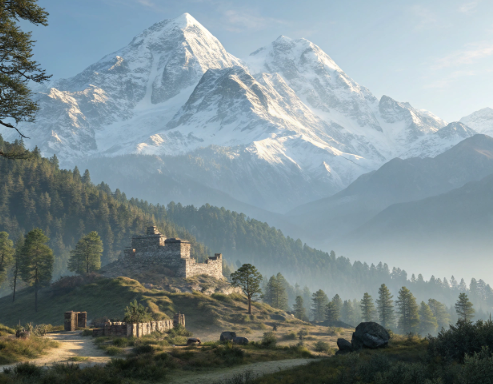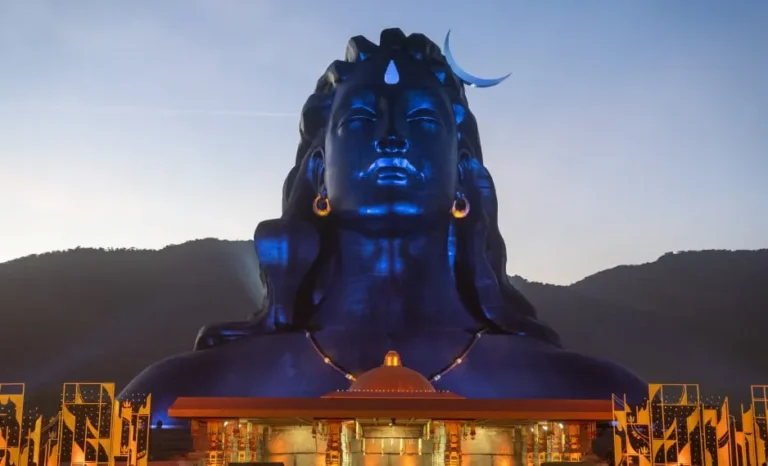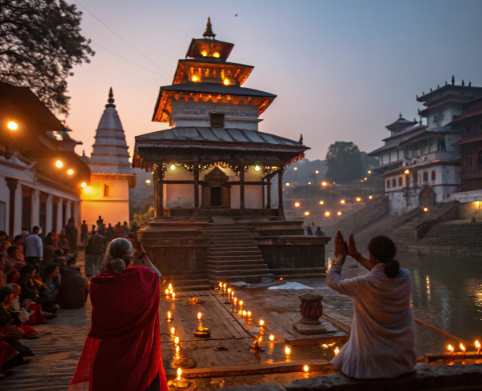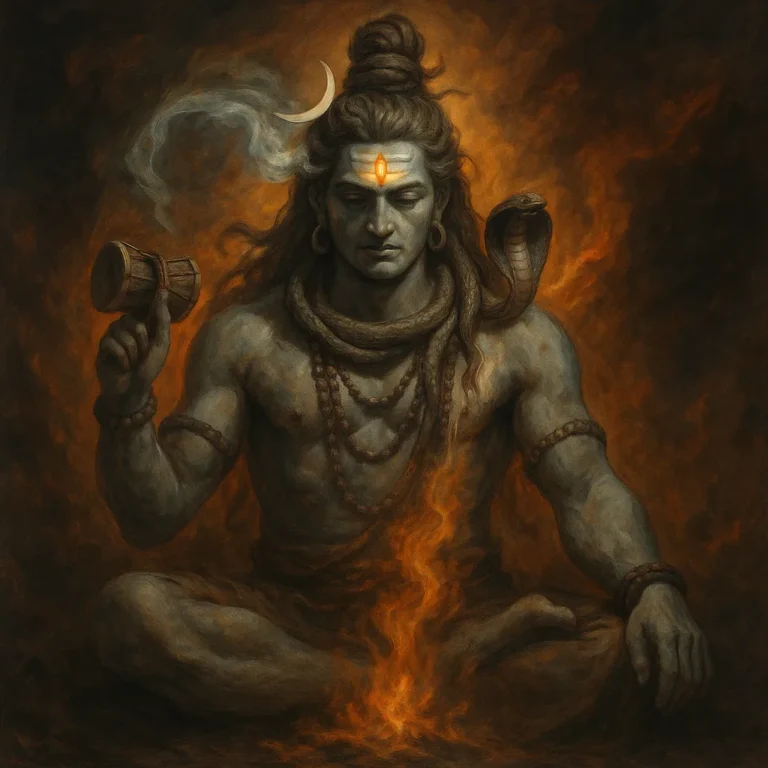Khait Parvat: Where the Himalayas Whisper Forgotten Stories
Nestled in the lesser-explored folds of the Indian Himalayas lies Khait Parvat, a mountain shrouded in silence and myth. Unlike the famous peaks that dominate postcards and trekking blogs, Khait remains almost untouched by modern tourism. But those who know the name also know the stories — strange, powerful, and persistent — passed down by villagers and wandering sadhus.

What makes Khait Parvat more than just another Himalayan elevation? Its folklore. Local narratives don’t speak of elevation stats or hiking routes. They speak of curses, divine wrath, and forbidden pasts.
The Mountain That Swallowed a Village
According to oral traditions from nearby Uttarakhand villages, Khait Parvat was once the site of a prosperous settlement. Generations ago, people lived at its base, thriving in agriculture and trade. However, arrogance and disrespect toward nature and the divine crept in, triggering a disaster.
The tale goes that a massive landslide, unexpected and deadly, wiped out the entire village. Survivors from neighboring hamlets claimed the earth trembled without warning, and the mountain “roared.” What’s eerie is that even decades later, vegetation refuses to grow where the village once stood.
Some versions say the destruction was divine punishment — the result of locals insulting a wandering sage or desecrating a sacred site. Whether viewed spiritually or geologically, Khait Parvat is now considered cursed land.
Why Locals Avoid Khait
No Temples, No Pilgrimage
In a region where most mountains are revered and host annual pilgrimages, Khait Parvat is notably excluded. No shrines exist on its slopes, no paths are marked for yatras. Even traditional Himalayan priests and temple caretakers keep their distance.
One reason might be fear of spiritual pollution. Local belief holds that Khait Parvat harbors unresolved energies, and that stepping into its domain without ritual protection could disturb the balance between the mortal and divine.
The Silence of the Forest
Khait’s surroundings are also known for being unnaturally silent. Locals report that birds avoid its upper reaches, and even herding animals instinctively skirt its edges. There’s an absence of wildlife sounds — no chirping, no rustling. It’s the kind of quiet that presses against your ears and makes you feel watched.
Mapping the Myth to Reality

It’s tempting to dismiss such stories as rural superstition, but Khait’s case invites a closer look. Is there a geological basis for the legend? Could environmental science explain what folklore wraps in symbolism?
Below is a table comparing local beliefs vs. observable facts:
Local Myth vs. Observed Reality at Khait Parvat
| Folklore Claim | Observed Element | Scientific/Alternative Explanation |
|---|---|---|
| Entire village disappeared in a roar | Historic landslide site still visible | Geological instability, possible seismic fault line |
| Land where nothing grows | Barren patches remain | Soil erosion or high mineral toxicity |
| Divine punishment for hubris | Sacred avoidance by locals | Cultural memory shaped by trauma |
| Animals avoid the area | Limited animal activity recorded | Possibly due to low food availability or seismic signals |
The overlap between oral history and environmental signals cannot be ignored. Just like ancient communities in other parts of the world marked flood plains or volcano zones with legends, Khait’s story might serve a protective function — warning people away from dangerous terrain.
The Role of Khait Parvat in Himalayan Storytelling
Khait Parvat isn’t just a location; it’s a symbol. In Himalayan storytelling, mountains are moral characters — capable of patience, wrath, and consequence. They reward reverence and punish neglect.
While sacred peaks like Kedarnath or Nanda Devi inspire devotion and pilgrimage, Khait represents the shadow side of the divine. It’s the unforgiving deity, the one who teaches through absence and loss. Its story reinforces a key Himalayan theme: nature is not to be owned or conquered, but respected.
Can Khait Parvat Be Explored Today?
Despite its fearful reputation, Khait Parvat has begun to attract a new kind of visitor: the curious traveler, the cultural anthropologist, the offbeat trekker. These aren’t thrill-seekers but rather people drawn by mystery, silence, and forgotten narratives.
Off the Grid, Off the Map
Unlike established trekking circuits like Valley of Flowers or Roopkund, there are no official trails to Khait. Getting there requires local guidance, a willingness to bushwhack, and absolute respect for the beliefs of surrounding communities.
Tourists are advised to speak to Gram Panchayat leaders or elders in nearby villages like Lohaghat or Champawat, who may share insights — or warnings. Entering Khait’s perimeter isn’t just a physical act; it’s a cultural transgression unless done with care.
The Relevance of the Khait Parvat Story Today
In an era where mountains are commodified as destinations, Khait Parvat offers a counter-narrative. Its silence challenges our desire to document, tag, and control every landscape.
More than that, Khait invites us to rethink how folklore preserves environmental knowledge. The myth of the buried village isn’t just a cautionary tale; it’s a record of disaster memory, passed through generations when no seismograph existed.
In a way, Khait Parvat may be the Himalayan version of what anthropologists call a “sacred no-go zone” — a place protected not by fences, but by collective memory.
Comparing Khait Parvat with Other Sacred Peaks
To better understand Khait’s unique place in Himalayan geography and belief systems, it helps to contrast it with other regional mountains:
Khait Parvat vs. Other Sacred Peaks
| Mountain | Cultural Role | Pilgrimage Activity | Known Legends | Tourism Level |
|---|---|---|---|---|
| Khait Parvat | Taboo zone, cursed land | None | Village swallowed, divine wrath | Extremely low |
| Kedarnath | Highly sacred (Lord Shiva) | High | Rebirth and penance of Pandavas | Very high |
| Nanda Devi | Goddess embodiment | Restricted | Goddess sleeps, angered by intrusion | Controlled access |
| Roopkund | Historic curiosity | Moderate to high | Skeleton lake, cursed army | High (seasonal) |
This comparison shows how Khait Parvat breaks the pattern. Where most Himalayan peaks draw in devotion and footfall, Khait repels. And in doing so, it perhaps safeguards itself from the exploitation that often follows discovery.
Respecting the Unspoken
Khait Parvat stands not as a monument to glory, but as a memorial to humility. It is a mountain that teaches by silence — not through rituals, festivals, or pilgrimages, but through what is absent. There are no trails, no shrines, no welcoming signs — and that, perhaps, is its most sacred feature.
While many peaks in the Himalayas are climbed, revered, or even commercialized, Khait Parvat remains untouched — protected by fear, memory, and local reverence. In this way, it serves as a reminder that some stories are not meant to be consumed, but remembered.
Approaching Khait is not about discovering something new — it’s about acknowledging something old, something older than maps and trekking permits. In the end, this mountain may never be part of guidebooks or popular lists — and maybe it never should be.
Anil Bhatt

मैं उत्तराखंड से हूँ और मैंने अपने दादा-दादी से खैत पर्वत की कहानी बचपन में सुनी थी। उन्होंने हमेशा कहा था कि वहाँ जाना अशुभ है। इस लेख ने उन यादों को फिर से जगा दिया। बहुत अच्छी तरह लिखा गया है — सम्मान और समझ के साथ।







